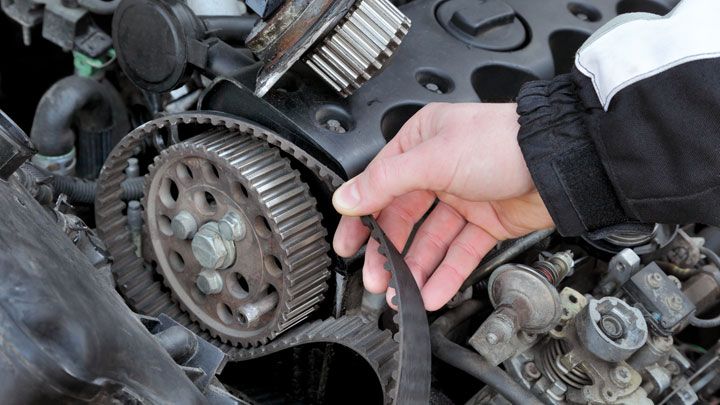
How To Identify A Damaged Belt?
Drivers must understand the significance of timing belt changes in order to maintain their engine functioning at peak performance and good car value. Knowing the importance and role of this feature of your car, you should keep an eye and ear out for any signs of a broken or failing timing belt.
Let’s take a look at the timing belt’s primary feature, the specific maintenance period for this component, the indicators and symptoms of a faulty timing belt, the causes of a broken timing belt, and a full replacement cost for a timing belt replacement.
What is a Timing Belt?
The timing belt is a rubber band that integrates the camshaft and crankshaft movements to maintain the gears running smoothly and the engine in perfect shape. If the timing belt, which is an important component of the internal combustion motor, breaks, the engine may be destroyed.
The function of the Timing Belt
The timing belt in a vehicle is critical in ensuring that the engine’s key parts and transmission work in unison. Usually, this element is always forgotten because it is just a small rubber piece, it is critical to keeping the engine valves open and closed at the proper intervals. These valves ensure that the engine receives an appropriate combination of air and fuel.
Ideal Interval of Timing Belt Change
Like most moving parts, the car’s maker can suggest a timing belt shift after a certain period of time. Since the time frame for timing belt replacement can be longer than for other components during repair cycles, you understand the signs of when it is time to replace it.
Symptoms That You Must Change Your Timing Belt
Timing belts do not always show a lot of signs and symptoms until they fail. A broken timing belt can cause slight signs, make loud noises, or simply break in your vehicle. The damage is also attributed to wear in the timing belt from not paying for a timing belt replacement.
You or your technician should physically inspect your timing belt to check if there is any apparent injury, splitting, glazing, or oil leakage. Furthermore, you should make a technician test the belt and ensure that the timing belt adjustment does not need to be made right away.
The problem in Starting Your Car
For instance, you may begin to note frequent problems in your car that can reduce the vehicle’s overall performance. If the timing belt fails, the car will not run and will not come to a complete halt. If you’re having issues in starting and halting your car on time, it’s time for a timing belt replacement.
Unnecessary Noises
Second, squeaking sounds emanating from the region of the timing belt protecting the engine is a sign of a faulty timing belt that can kill your engine. This is an indicator that the belt is beginning to tear way, has been weakened over time, and has been exposed to discomfort due to repeated usage. A repair might be required to prevent the damaged timing belt from causing further damage in this situation.
Quirky Engine Sound
Furthermore, another warning that your faulty timing belt is about to wreck your engine is that it suddenly starts to sound like it’s going at a much higher pace than normal, even though you’re driving at reduced speeds or when your vehicle is rough idling.
- Since the timing belt is missing, the flywheels are not experiencing enough friction throughout rotating to fuel the engine. If you learn that your vehicle’s flywheel is not working correctly, it is time to repair the timing belt.
Misfiring Engine
Misfiring of the engine is also an indication that it is time for a timing belt transformation. The engine’s firing rate can be jeopardized as the timing belt and teeth wear out over time.
- If the timing chain drifts away from the gears, the cylinders may open and close too quickly, resulting in an engine misfire.
- If your engine is misfiring, your spark plugs can be clogged. In this scenario, replacing the spark plugs in your car would cost between $100 and $300.
Timing Belt Snaps
Another indication of a faulty timing belt is that there are no warning signals for the engine, but the timing belt will still break. A completely broken belt will ultimately kill your engine, causing it to lose all control. While certain cars may be pushed for small areas after the timing belt snaps, driving without a timing belt shift can cause irreversible engine damage.
Signs of Metal Chain Failure
Finally, if the vehicle is equipped with a timing chain rather than a timing belt, a metal chain will have more visible signs of weakness than a timing belt. It would be simpler to see in this situation that your timing belt will kill your engine. The metal chain will start to rattle when in operation, indicating that it is not sufficiently tensioned and requires an urgent timing belt replacement.
Time for Timing Belt Change
Timing belts must be changed at particular times prescribed by the car guide or by a professional who checks on the car regularly.
The maintenance cycle is typically determined by a certain time span or suggested distance. Failure to repair the timing belt will lead to engine wear and tear, negligence, breakdown, and catastrophic engine failure.
In most cases, the owner’s manual repair time period for a timing belt shift in their vehicle is between 30,000 and 50,000 miles.
Identifying the prescribed repair period for a timing belt change in your particular vehicle will assist you in keeping the engine running safely and avoiding high auto repair costs! If you do not want to engage yourself in the repairing procedure, the best option is to sell your car. Acres Cash for Cars is one of the best car buyers in NJ.
